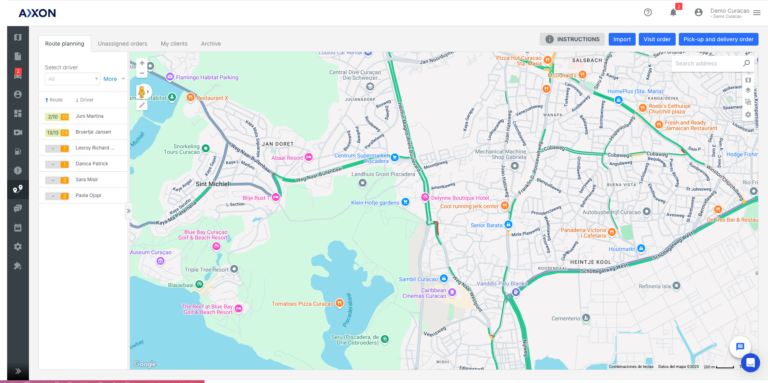How to Create an Effective Safety Policy
Here you'll find the crucial steps to develop a robust policy that protects both your employees and your business assets.
Understanding the Importance of a Fleet Safety Policy
Implementing a fleet safety policy is not just about compliance, it’s about cultivating a culture of safety within your organization. A comprehensive policy:
- Protects Employees: Ensures the well-being of drivers and other road users.
- Reduces Costs: Minimizes accidents, which can lead to costly repairs, legal fees, and increased insurance premiums.
- Enhances Reputation: Demonstrates a commitment to safety, which can improve public perception.
- Ensures Compliance: Helps meet legal and regulatory requirements.
Key Components of an Effective Policy
An effective fleet safety policy should encompass the following elements:
a. Purpose and Scope
Define the objectives of the policy and specify who it applies to (e.g., all employees who operate company vehicles).
b. Driver Responsibilities
Outline expectations for drivers, including:
- Valid driver’s license maintenance.
- Compliance with traffic laws.
- Reporting of incidents or violations.
c. Vehicle Use Guidelines
Specify permissible uses of company vehicles, addressing:
- Personal use restrictions.
- Authorized passengers.
- Prohibition of substance use while driving.
d. Driving Behavior Expectations
Set clear standards for:
- Adherence to speed limits.
- Use of seat belts.
- Prohibition of distracted driving (e.g., texting).
e. Vehicle Maintenance and Safety Checks
Establish procedures for:
- Regular vehicle inspections.
- Reporting maintenance issues.
- Scheduled servicing.
f. Fleet Management Devices
Address the use of devices such as:
- GPS Tracking: For route optimization and monitoring.
- Telematics Systems: To record driving behaviors.
g. Prohibition of Tampering with Devices
Clearly state that tampering with fleet management devices is prohibited and outline consequences.
h. Consequences of Policy Violations
Define disciplinary actions for non-compliance, which may include:
- Warnings.
- Suspension of driving privileges.
- Termination.
i. Training and Compliance
Implement:
- Driver safety training programs.
- Regular policy reviews and updates.
j. Policy Review and Updates
Establish a schedule for reviewing and updating the policy to ensure it remains current.
Step-by-Step Guide to Creating Your Policy
Follow these steps to develop a comprehensive fleet safety policy:
Step 1: Define the Purpose and Objectives
- Mission Statement: Begin with a clear statement that reflects the company’s commitment to safety.
- Objectives: Outline specific goals, such as reducing accidents by a certain percentage.
Step 2: Identify Applicable Laws and Regulations
- Research Local Laws: Understand traffic laws and regulations in all areas where your vehicles operate.
- Compliance Requirements: Ensure the policy meets or exceeds legal standards.
Step 3: Outline Driver Responsibilities
- License Requirements: Specify that drivers must hold a valid license appropriate for the vehicle class.
- Reporting Obligations: Require prompt reporting of accidents, violations, or changes in license status.
- Health and Fitness: Encourage drivers to maintain health standards necessary for safe vehicle operation.
Step 4: Establish Vehicle Use Guidelines
- Authorized Use: Define who is allowed to drive company vehicles.
- Personal Use Policy: Clarify if personal use is permitted and under what conditions.
- Passenger Policies: Specify rules regarding passengers, including hitchhikers and non-employees.
Step 5: Set Clear Expectations for Driving Behavior
- Speed Limits: Emphasize adherence to posted speed limits.
- Seat Belt Use: Mandate the use of seat belts at all times.
- Substance Prohibition: Prohibit driving under the influence of alcohol, drugs, or medications that impair driving.
Distracted Driving: Ban texting, emailing, or using handheld devices while driving.
Step 6: Address Vehicle Maintenance and Safety Inspections
- Inspection Procedures: Provide checklists for pre-trip and post-trip inspections.
- Maintenance Reporting: Establish a system for reporting and addressing maintenance issues.
- Scheduled Servicing: Set intervals for routine maintenance.
Step 7: Include Policies on Fleet Management Devices
- Device Usage: Explain how devices like GPS and telematics will be used.
- Data Privacy: Address how data will be collected, used, and protected.
- Tampering Prohibition: Clearly state that tampering with devices is forbidden.
Step 8: Define Consequences for Policy Violations
- Disciplinary Actions: Outline the steps that will be taken for different levels of infractions.
- Consistency: Ensure that consequences are applied fairly and consistently.
Step 9: Develop Training Programs
- Initial Training: Provide training when the policy is introduced or when new employees are onboarded.
- Ongoing Education: Schedule regular refresher courses and updates.
- Specialized Training: Offer additional training for specific vehicles or equipment.
Step 10: Implement and Communicate the Policy
- Distribution: Provide copies of the policy to all affected employees.
- Acknowledgment: Require employees to sign an acknowledgment of understanding.
- Open Communication: Encourage feedback and questions.
Step 11: Monitor Compliance and Review Policy Regularly
- Tracking Systems: Use fleet management software to monitor driving behaviors.
- Regular Audits: Conduct periodic reviews of compliance.
- Policy Updates: Revise the policy as needed based on new laws, technologies, or company changes.
Important Considerations
When creating your fleet safety policy, keep the following in mind:
- Legal Compliance: Stay informed about regulations from agencies like the Department of Transportation (DOT).
- Record Keeping: Maintain accurate records of driver qualifications, vehicle maintenance, and incident reports.
- Involvement: Involve employees in the policy development to gain insights and encourage acceptance.
- Incentives: Consider implementing reward programs for safe driving records.
- Transparency: Be open about the use of tracking devices and how data is used.
- Data Protection: Implement measures to protect personal information.
- Company Culture: Align the policy with your organization’s values and culture.
- Scalability: Ensure the policy can adapt to changes in fleet size or operations.
A fleet safety policy is a critical step in promoting safe driving behaviors, reducing accidents, and protecting your company’s assets.
If you follow this detailed guide, you can develop a policy that not only meets legal requirements but also fosters a culture of safety within your organization.
Remember, the effectiveness of the policy depends on proper implementation, regular communication, and ongoing commitment from both management and employees. Your team must stay proactive in reviewing and updating your policy to adapt to new challenges and technologies in fleet management.
If you ever have any questions regarding the safety of your vehicles and operations, do not hesitate to reach out.



